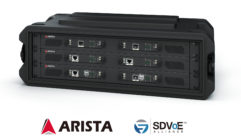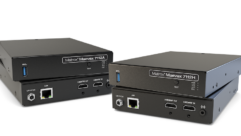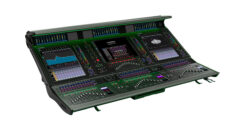
Streaming Video and Audio, Part 2
Mar 25, 2010 4:18 PM,
By Bennett Liles
Listen to the Podcasts
|

Yamaha found success using the NewTek TriCaster for its live streaming components of the its website, the Hub, including training.
We’ve all seen streaming video on the receiving end, but on this edition of the Corporate AV podcast, Yamaha’s Jeff Hawley and Philip Nelson from NewTek are here to tell us about how the TriCaster makes things easy for Yamaha to get live streaming online at the production end.
Related Links

Streaming Video and Audio, Part 1
What used to take a remote truck, a production crew, and a satellite van can now be done with a couple of people, a few pieces of hardware, and the NewTek TriCaster….
SVC: Jeff and Philip, thanks for being with me again for part two of the Corporate AV podcast. Jeff, we were talking before about this live webcast that Yamaha did. I guess this was sort of the test flight of the program at the Pasadena Jazz Institute. Now, when you set that thing up, you were mixing live music. Did you have to use any kind of external compression on that audio before feeding it into the TriCaster inputs?
Hawley: Well, that particular event was not our normal setup. Again, we didn’t have a lot of time just to work on that in advance. It was a little bit of a 11th hour decision—“Hey, let’s go ahead and give this a shot and see what can do with a live broadcast.” And again, not being that familiar with the TriCaster at that point, we opted to really play it safe. So we had the audio feeds coming off the stage. We basically split that out to the normal live console where the house engineer was just doing the mix as he normally would. We ran a split off of that into an O2R96 and then down to a stereo pair that went into the TriCaster. Out of the O2R96, we also ran another split that was going directly out to a Steinberg MR816 audio interface into a Mac Pro, and they were running Cubase 4. The Steinberg team that has been a part of Yamaha, actually, was there to help us. So in that case—again, just playing it safe—we had the TriCaster getting a dedicated audio mix.
Nic Chaffee, who is a great audio engineer that works with me here at Yamaha, was manning that station and really worrying only about broadcast audio. So as I was switching the show, I was just looking at a stereo pair—making sure we weren’t peaking. That’s what went out to the audience live. We also had the Steinberg rig that was capturing to tape for postproduction editing and mixing and things for the on-demand version. Again, just not knowing really what was going to happen, but it ended up that the two were pretty darn close.
The live mix was terrific. We were able, obviously, to do a little more tweaking in the postproduction stuff out of Cubase and get a little bit fancier with it. We also took the broadcast video mix. The other thing that maybe I hadn’t mentioned or maybe you didn’t know is that the neat thing about the TriCaster is not only can you do the live feed directly to the Web, but you can capture to the hard drive on the device. It captures all the transitions. It captures the audio—basically whatever the viewers are seeing live is captured to the device. So we have that immediately available after the show, chop that into a couple of pieces, and use that as a preview snip bit on the Hub on-demand.
The event happened on Sunday, and I think on Monday we put that little snippet of the show up and said, “Tune back in in a couple of days. We’ll have an HD version.” So we did all the audio mixing in Cubase, synced that back up with HDT from the cameras, did our normal turn around in [Apple] Final Cut, synced everything back up, and basically, on the Hub, if you check it out now from that event, we have what we call HD. Technically, it’s the Apple TV format. But if you download that, you’re listening, in that case, [to] the Cubase mix that we did for the show and that’s from Sony HD cams. We edited in Final Cut, but the neat part is, immediately the day of the show, a couple of minutes after the show, we would have been able to take that off and have the actual live switching and live audio available basically instantly. …Basically that bought us some time. We could get something right up on the on-demand site and say, “Give us a day or two to do all this editing”, and that’s what we ended up doing.
Philip, do you need an external mixer and audio processing on the input signal?
Nelson: The TriCaster has a built-in audio mixer that gives you basic audio editing or audio control. You have your faders, you have your balance, you have your simple EQ, but most clients that use TriCaster—especially for high-end audio environments—they use an outboard audio mixer to feed a master audio feed into the TriCaster. So the audio inputs in the TriCaster are simply setting your levels, and the TriCaster and your audio mixing is normally done on outboard gear so that they could add in compression effects and have the dedicated audio engineer running the audio of the show.
And Jeff, from a strictly hardware stand point, what sort of audio levels and audio formats can you feed into that?
Hawley: Maybe Philip could speak a little more to the specifics on it. I know that it does accept a line or mic levels, basically combo XLR connectors, so XLR or balance ¼ inch. In the soft ware side, you do have adjustable gain; you can select line or mic. Generally we do have a pad in front of it—some sort of a mixer. Again, maybe Philip knows that exact off of the top of his head. I think, if I remember correctly, I think it wants to see -10dB. So if you’re sending it +4, you will need to pad that or, again, have a mixer in line.
And there is also an RC line input. Every once in a while I will just plug in just a simple CD player or something if we need background music—something in a broadcast break. And as far as the audio formats on the device, if I didn’t want to bring along a CD player to run into that line input, there is also essentially, like in previous live broadcasts, toaster sort of units. They were called VCRs. On the TriCaster, it’s a DDR, but you have two DDR channels and you can playback MP3 for sure. I know WAVs support it. I would go out on a limb and say that basically any standard audio should work for you.
And Philip, you’ve got some choices on those streaming audio formats, right?
Nelson: The TriCaster allows you to stream both Windows Media 11 and Flash and VC1 as a format. And you can select what ben rate and what frame rate and even what resolution you stream at. So it really allows you to pick the amount of bandwidth that your current venue will allow you so you can pick the highest quality that is available at your current venue.
Streaming Video and Audio, Part 2
Mar 25, 2010 4:18 PM,
By Bennett Liles
And Jeff, you had this out in the field recently. It’s obviously easily portable.
Hawley: Yeah, and I have seen a couple of guys, I think even on the TriCaster side, if you dig around, that there is a bag even available for it. You could toss it in a backpack and not be bending over backwards. It would be, if I had to guess, I would say probably 8lbs. to 12lbs., somewhere in there. It’s definitely lightweight and small.
[In part one], we were talking about the different ways that you could use [the TriCaster]. Yamaha has got into so many things that you can use the live streaming for just about anything. Obviously, training would be a big one.
Hawley: Yeah, and in part one, we talked a little bit about what sort of things are on the Hub and a little bit of the history of the Hub. Somewhat recently in the evolution of that site, we added in a dealer training component. I would just say probably back in 2005, we had one of our divisions—the band and orchestra division, so wind instruments, trumpets, trombones, saxes, tympanis, violins—[post] basically glorified keynote or Power Point presentation that we created intended for our dealer network. You would watch one of those videos and a series of questions that you would answer after each one, and once you completed them all, you were certified. So nothing really groundbreaking. There were a lot of elearning programs and a squirm format sort of thing. If anyone was really heavy into that sort of elearning, they definitely would understand our system and what was in place at that time.
What happened is that it actually took off, at least in the music manufacturing side of things. There was really no one else in the industry doing that so it really took off and was really popular with our dealer base, and we saw some really great returns. The people who had completed the entire batch of training modules [saw] double-digit increases for per store sales for Yamaha products. Just right off the bat, this is something that the dealers were asking for and once they had access to it. Just simple video training was really quickly paying off.
So going back, 2005, it was awesome—big waves, great. Then we cloned it and basically made it available with content from another division covering guitars, drums, so on and so forth. Our piano division had gone to an outside company and had another solution for training develop. So full-line dealers had, “I go here for guitars; here’s my log in for trumpet; then I need to know about pianos, so here’s my other thing that’s totally different sort of side and log in.” So at some point, I realized this isn’t very consumer- or dealer-friendly in any way. So [I] took on the huge task of basically pulling all of that data, all of the content, all of the systems, all of the access, all of the passwords, everything into one new system, and built that into the Hub. So for authorized dealers, you have access so that if you are on the Hub, you click on Yamaha Online University, there is a little link you will see there once you enter in your dealer information and are into the site. Instead of a saxophone artist talking about their history and their tour stories or a concert, it would be, “Here is a Yamaha motif synthesizer; here is how the operating system functions”—a little bit deeper technical sort of material, and after that, you are tested on it. The same basic concept, but all that rolled into the Hub.
What are your future plans for this? Have you got anything in the works coming up for a live streaming content now that you are not doing yet?
Hawley: Well, back to one of your previous questions. For Yamaha, it’s kind of built in that we can do concert broadcasts. We can do these events and we can make things that are maybe a little bit more entertaining and kind of [have] some sexiness to them built-in, but it’s someone playing a jazz concert—a little bit, maybe, more interesting to viewers than a staple company or something. That being said, really, I am looking at this point at how to really connect directly with our dealers. And now taking that dealer training concept, the on-demand side of that is working out really well. Taking it one notch further, [we’re] thinking that it would be awesome to connect directly with the dealer network and let’s [for example] get 10 people at Joe’s Music in Deluth to tune in for a special training session with our top marketing guys or our customs shop custom saxophone builder—[making it] one on one [to have] more of a connection with the people and the real high-end products that Yamaha offers and offering that additional support and training to our dealer network. I think that is one area that we are definitely going to look into. And the other thing that is really neat about the TriCaster is the greenscreen; [it’s] kind of [a] custom live set. The ability to just throw up a simple greenscreen and have the TriCaster basically fill that in and emulate a full production set [with] reflections on the tables. You would be hard-pressed to tell the difference between the live set and a real actual production studio.
Philip, what can really you do with that capability?
Nelson: Well, TriCaster is a portable live production system. When we designed it, our concept was a live TV truck. The power of that live TV truck you would see outside of a concert venue or a sporting venue shrunk down into a 10lb. or 20lb. box. And we have taken it to a new level with virtual sets because, in addition to video switching, graphics, and rolling in video clips and mixing audio, you can add in a greenscreen and you can make a little 5ft.-wide greenscreen look like a million-dollar television studio, and we include photorealistic virtual sets in the TriCaster so you can take your show and make it look as big as you want.
That would be a big attraction now; I mean this doesn’t come of like the old 1970s weather man chroma key or anything. These seem to be fairly convincing-looking things. I have seen some of the web demos, and it seems pretty sophisticated really for such a small easy portable unit.
You know, it’s funny that you mentioned the 1970s weather man because when some people think of virtual sets, unless you have millions of dollars for the top-of-the-line virtual sets systems, most virtual sets systems look like the ’70s weather man. And one of the benefits of TriCaster is that we do have more of the photorealistic virtual sets where it’s not just a person keyed over a background—it’s actually a person placed in a virtual world. So the talent is sitting behind a virtual desk, sitting in front of virtual plasma TVs, with live video running in those TVs, and the talent is reflecting in the floor and on the desk, and the lighting in the set looks realistic. [With] the TriCaster CCXD300, which is the high-depth version of TriCaster, you can actually zoom the virtual camera in the virtual set. So with the camera that is locked down on an announcer sitting in front of a greenscreen, I can make it look like we are in a wide shot in a giant multimillion dollar studio and then zoom that virtual camera in on that talent.
Really slick. How about those virtual sets Jeff?
Hawley: Just a cool feature of the TriCaster that I am kind of anxious to try that I think for maybe smaller tradeshows that are not quite the size of NAMM when we do a regional show, it might be neat to set up a little interview area and have our cool-looking world of Yamaha movie set—[a] production set that is all within the TriCaster and is all just a 3D space. [That’s just] a couple of cool things that I am really anxious and looking forward to trying out.
All right. It sounds like you have got it going with live broadcasting on the Internet using the NewTek TriCaster. And Jeff Hawley from Yamaha and Philip Nelson from NewTek, thanks for being here.
Hawley: Great, thank you.
Nelson: Thank you for having me.









